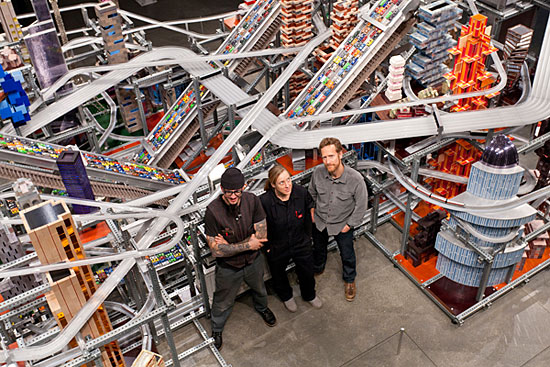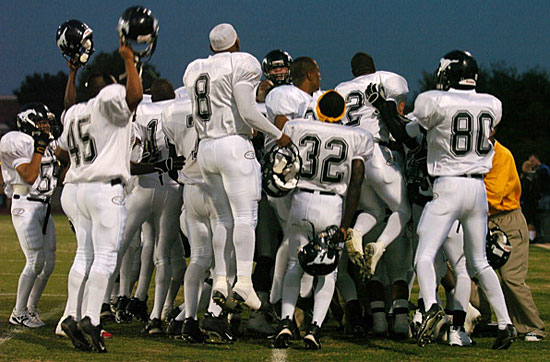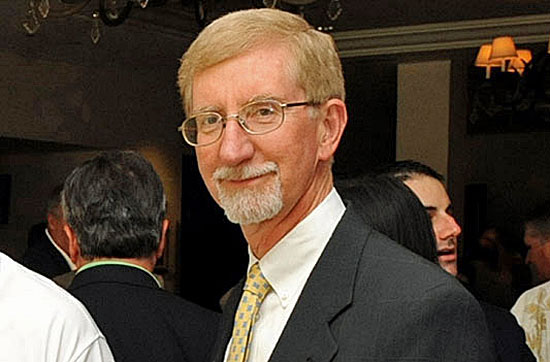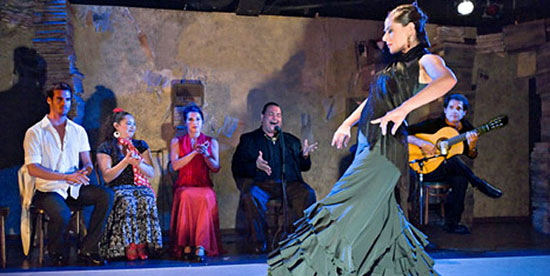Reimagining an old dream
February 15, 2012

The Valley Performing Arts Center's Experimental Theatre is the setting for a new production of "Life is a Dream."
Centuries-old stories of European kingdoms take on new relevance in Milo Cruz’s Pulitzer prize-winning adaptation of Pedro Calderón de la Barca’s “Life is a Dream.” Students at California State University, Northridge (CSUN) will perform the new version beginning this weekend at the Experimental Theatre of the Valley Performing Arts Center.
“Life is a Dream” examines some of the deepest mysteries of reality. It ponders the tension between liberty and destiny and questions whether life is but an illusion. In Cruz’s adaptation, these questions are put in the context of a humankind that can simultaneously produce transcendent art and vicious genocide.
The production is the first directed by Larry Biederman, the new head of the school’s directing program.
The show runs February 17-19 and February 22-26. Curtain times are at 7:30 p.m. except for Sunday performances, which start at 2 p.m. Tickets are $20 for general admission, $17 for seniors and $15 for students. They may be reserved by calling (818) 677-2488. For directions and parking, please see the arts center’s website.
Posted 2/15/12
Seeking ultimate clarity in beach law
February 15, 2012
The beach-loving Ultimate Frisbee community has a message for the Board of Supervisors: Game on.
Several Ultimate Frisbee devotees, concerned about the impact of a new beach ordinance on their sport, came to the Hall of Administration Tuesday to give supervisors a piece of their minds—but ended up giving them a tutorial on the game, too.
“I don’t know what Ultimate Frisbee is. I’m sure it’s a great sport…But if you’re throwing projectiles around a beach when there are hundreds of thousands of people at the beach, the public safety comes first…It’s common sense that we’re asking you to employ,” board chairman Zev Yaroslavsky told the visiting players before asking them to explain their game.
“It’s a team sport. On the beach, it’s four on four or five on five, on a football-type field, not that big, with two end zones. And you advance the disc by throwing it to people on your team and you score by throwing it to a teammate in the end zone,” explained Alison Regan, a member of the Los Angeles Organization of Ultimate Teams, or LAOUT.
Yaroslavsky wondered how that would work in the midst of summer beach crowds: “So on a 90-degree day in Santa Monica in July or August, I would imagine it’s pretty tough to find space to have a game like this?”
“The beaches are large enough that we usually find some room,” Regan replied. “But we have to be accommodating, you’re right. When the public wants to walk through, we have to stop our play and we let the public walk through.”
It was the growth of new beach sports such as beach tennis and soccer that led to a recent liberalization of the county’s rules on ball-playing on the sand.
However, widespread erroneous media reports last week claimed that the county had enacted $1,000 fines for football and Frisbee playing at the shore, sparking a local uproar that quickly was heard ’round the world.
Although Department of Beaches and Harbors director Santos Kreimann moved to clarify the policy, saying that the new rules actually permitted football- and Frisbee-playing as long as it didn’t endanger other people on a crowded beach, the Ultimate Frisbee contingent was still troubled.
Tiffany Wallace, who plays on Solidarity Ultimate, which she described as a social justice Ultimate Frisbee team, said people should be allowed to use “Frisbees, footballs, soccer balls, even Ping Pong balls” at the beach without prompting “selective enforcement” under a too-vague ordinance.
Her sister, Julia Wallace, also addressed the board. “If the law is on the books, that’s enough to cause fear,” she said. “So it actually has to change.”
The board agreed. Supervisors, acting on a motion that Supervisor Don Knabe had submitted before the players testified, ordered a rewrite of the Frisbee- and ball-playing section of the new ordinance.
The new language should clearly state that “such activities by small groups and individuals are allowed at all times on the County beach” unless lifeguards direct otherwise for public safety reasons, the motion said.
Supervisor Mark Ridley-Thomas suggested that the players come back for an Ultimate Frisbee demonstration sometime.
And on their Facebook page, Ladies of La—Women’s Ultimate Frisbee, the disc-hurling activists declared victory.
Posted 2/15/12
Andalusian dancing in the park
February 15, 2012
That’s not thunder you’re hearing—it’s the rhythmic stomping of flamenco dancers.
This Sunday, East Hollywood hosts the latest installment of “Forever Flamenco,” featuring the energetic sounds and moves of Compañía Manuel de la Cruz. The eponymous dancer and artistic director will join San Francisco guitarist Jason “El Rubio” McGuire and singer José Cortés, from Spain.
The show takes place in the Barnsdall Gallery Theatre, which presents diverse theatre, dance, music, spoken word performances, lectures and films at low cost to the public. The theatre is one part of the city-run Barnsdall Art Park. The park is also home to famed architect Frank Lloyd Wright’s Hollyhock House, the Municipal Art Gallery and art workshops for children and adults.
Compañía Manuel de la Cruz, presented by Fountain Theatre, takes the stage February 19 at 8 p.m. Tickets to the event range from $25 to $45 and may be purchased online or reserved by calling (323) 663-1525. Directions, park hours and other details are available on the art park website.
Posted 2/15/12
Streaming live from the Valley
February 15, 2012

Phase I of the Tujunga Wash Ecosystem Restoration Project has already grown lush. Phase II is underway.
The San Fernando Valley is about to get a little greener. Phase II of the Tujunga Wash Ecosystem Restoration project breaks ground next Wednesday. By the time it’s completed, it will have restored ten acres of open space and created a sustainable stream system in the neighborhood of Valley Glen.
The $7 million project is a joint effort by the Los Angeles County Department of Public Works and the United States Army Corps of Engineers. The area to be restored is 3,000 feet long and 65 feet wide on each side of the wash. The finished section will link two existing “greenbelts”—Phase I of the project and an “original” greenway from the 1970s, forming 13,200 consecutive feet of revitalized land.
For the ecosystem, the project means nesting for migratory birds and a corridor for wildlife movement. Native vegetation will be installed, and the new stream will give local plants a chance to take root. The stream will replenish groundwater and act as a natural filter to urban runoff.
“The goal is to mimic Tujunga Wash in its natural state, but on a smaller scale,” said Richard Gomez, project manager for Department of Public Works.
For humans, the project offers a place to walk, learn and explore. Ornamental gates will mark entry points, a 12-foot-wide path will give pedestrians and bicycles room to meander and educational signage will teach visitors about the local ecosystem and the project itself. Benches and rock wall seating will offer folks a place to rest amid the greenery. Existing chain-link fencing will be replaced with more aesthetically pleasing material.
A ceremonial groundbreaking will take place at 10 a.m. on Wednesday, February 22, at the intersection of Vanowen Street and Fulton Avenue. Speakers include Supervisor Zev Yaroslavsky, Colonel R. Mark Toy and Public Works Director Gail Farber. The public is invited to attend.
The Tujunga Wash feeds into the Los Angeles River in Studio City. In the first half of the 20th century, repeated flooding of the channel caused widespread property damage and even some deaths. As a result, in the 1950s the Army Corps of Engineers lined nine miles of it with concrete. This and other human activity had the unintended effect of eliminating the natural habitat of the waterway.
The longterm hope is revitalization of the entire length of the Tujunga Wash, said Gomez. When the current project is completed this fall, that goal will be 3,000 feet closer.
Posted 2/15/12
One dream, many hands in Metropolis II
February 15, 2012

Many helped build Burden's city, including Rich Sandomeno, Alison Walker and leader Zak Cook. Photo © 2012 Museum Associates/LACMA
Chris Burden’s vast, new miniature skyline may have been one artist’s urban vision, but behind the scenes, it took a village to build “Metropolis II”.
“It was a long process—almost five years—and it took a lot of people,” says the L.A. artist on a recent morning at LACMA, straining to be heard over the din of his creation. The idea, he says, was to evoke the energy of a modern city; around him 4,400 tiny toy wheels on 1,100 toy cars whoosh around an elaborate thicket of toy skyscrapers at up to 240 scale miles per hour.
The room-sized piece, opening to the public January 14, is on long-term loan to the museum from its owner, LACMA trustee Nicolas Berggruen. A big hit in sneak peeks last month, it will be available for viewing anytime, but will only operate Fridays through Sundays, with a special showing on the Martin Luther King, Jr. holiday.
Situated just a short walk from Burden’s iconic “Urban Light,” it is mesmerizing and frenetic, a singular vision of a way of life familiar to every visitor with a car in the parking garage of the museum. But Zak Cook, Burden’s lead engineer, says as many as eight people at a time were assigned to the project, working under the artist’s watchful eye in his rural studio in Topanga.
“In all,” he says, “probably 14 people had a hand in it.”
Hiring crews of assistants isn’t unusual for successful artists, who often need extra hands and special expertise to execute large-scale ideas. “It doesn’t take away from the fact that it’s Chris’ work,” Cook notes. “The work couldn’t exist without Chris. It could exist without me.”
Burden’s crew, like the piece, reflected Southern California: There were two special-effects artists and two college-level art instructors, a maker of artisan snowboards, woodworkers, ceramicists and assorted masters of fine arts from UC Riverside and UCLA. One of the craftsmen on the prototype was the lead guitarist in the L.A.-based band “Dengue Fever.” Much of the infrastructure and train wiring was done by a heavy diesel mechanic-turned-jewelry-designer who was a finalist last year on Lifetime Television’s “Project Accessory.”
Some laid the Plexiglas track. Some built the dreamlike skyscrapers. Some installed the intricate floors and platforms. UC Riverside MFA Alison Walker and the “Project Accessory” finalist Rich Sandomeno came to know the piece so well that LACMA has since hired them to operate and maintain “Metropolis II” and act as a sort of pit crew.
“It was supposed to be a 9-month job and I ended up working on it for three years,” joked Sandomeno. “But it’s been so great to work with Chris and Zak and all the other artists. Besides, he adds: “When I was a kid, I loved Hot Wheels. “
The combination of Burden’s vision and all that painstaking labor is as intricate and playfully serious as art gets—a vast, buzzing skyline that has been compared to New York, L.A., “The Jetsons” and the 1939 World’s Fair. In the course of an hour, the tiny vehicles whip around the thicket of fanciful high-rises a collective 100,000 times on 18 lanes of traffic.
“It’s a city of the past and a city of the future,” says Burden. “It’s a city of the past in the sense that the cars run free, and a city of the future in their speed.”
An earlier, much smaller, version, with only about 80 cars, was built in 2004 for a Japanese museum, Burden says, “but they showed it for six months and then the museum changed direction. “ After the piece was put into storage—“all that work and then nobody got to see it”—Burden decided to make another Metropolis that would be “bigger and better.”
“Metropolis II,” however, took on a life of its own, says Burden: “I think we finished right around the time of Carmageddon. Every building took three or four months, which, I think you could build a tract house in that time.”
Cook served as general contractor for Burden’s architectural direction, working out such not-so-minor details as how to make the cars move reliably. (After much trial-and-error, Cook invented a sturdy, yet invisible, electrically powered conveyance system that hauls the toy cars uphill with magnets, like a rollercoaster, then releases them.)
Burden guided the team closely, Cook says, but also welcomed their input. Many contributed ideas for the exquisite buildings, which the team gave informal names: “AzDec Plaza” was a half-Aztec, half-Deco extravaganza contributed by Walker. An octagonal black high rise with blue windows, built by painter and fellow MFA Greg Kozaki, was known as “DarkTower.” A beautiful blue-and-green glass tile skyscraper was dubbed “Linkous Tower” by Frank Diettinger, a mold-maker who had done special effects for films such as “Sleepy Hollow” and “Bride of Chucky”, and who wanted to honor deceased indie singer-songwriter Mark Linkous.
“Whoever built it got to name it,” says Cook, adding that there was one major exception. “There’s an Eiffel Tower-looking building made from erector set parts, with the uppermost narrow part kind of extended, and Chris named that one.”
“Yeah,” laughs Burden, “I call it ‘Viagra Tower’ because it’s too tall.”
Cook worked on the piece from its inception. Of all the team members, he acknowledges, he probably has the least artistic resume. The 42-year-old son of a former Time correspondent, he graduated from UCLA with a degree in geography and worked for several years in the consulting division of CALSTART, a Pasadena-based clean transportation consortium.
But after a trip to India in 2000, he says, he realized that he didn’t want to keep doing white papers on the environmental impact of ports and airports; he wanted to write fiction and children’s books.
In search of a day job, he got a call one day from a friend who worked for Burden’s wife and fellow artist Nancy Rubins; Burden needed someone to help restore his 1998 sculpture “Hell Gate”, a massive bridge made of erector set pieces. The friend knew that Cook had done construction work in college.
Learning on the job, Cook then went on to help Burden build several more major pieces, including Burden’s 2001 “Bateau de Guerre”, a massive battleship made of gas canisters, and his 2002 model of a British landmark, “Tyne Bridge”.
Burden jokes that Cook “was in charge of work-ethic.”
“He’s very precise and thorough,” says the artist. “I couldn’t have done this work without somebody like him.”
Cook says that now that “Metropolis II” is finished, he intends to return to his own pursuits, and maybe finally finish those children’s stories.
“Not that Chris and I would rule out working together again in the future, but, honestly, this is such a great note to go out on,” he says, watching from a balcony at LACMA as the traffic hums by in the city that he helped make.
“I don’t see how I could ever top this.”

Chris Burden with his creation, created in his Topanga workshop. Photo © 2012 Museum Associates/LACMA
Posted 1/12/12
From pain, pure poetry in Room 219
February 15, 2012

ESL students at Fairfax High turned personal struggles into poetry for a recent performance. Photo/Clive Alcock
The players included a teenager from El Salvador missing her faraway mom, a boy from Africa’s Ivory Coast telling a family secret, a girl from Israel wrestling with what it means to be real, not “plastic.”
They spoke their lines with honesty and transparent emotion. Dressed all in black and moving about a spare stage, they took turns in the spotlight, young faces aglow.
Was this a pitch-perfect ensemble created by a Hollywood casting director? Or maybe an off-Broadway troupe preparing for a long theatrical run?
Hardly. This group came together in Karen Ritvo’s English as a Second Language class at Fairfax High School.
And the words they spoke were true—wrenched from the struggles of their real lives and spun into autobiographical poetry as part of a special collaboration with the Music Center.
When the students took the stage recently for a one-time-only performance at the Greenway Arts Alliance theater on the Fairfax campus, it was the culmination of a creative and transformative process that had started months ago with studying the art of others: Pablo Neruda’s Poetry and Alvin Ailey’s Revelations.
Soon, the students were coming up with revelations of their own, as they began crafting poems based on real experiences of struggle and change.
Some grappled with universal experiences of being a teen—a first kiss, or the heartache posed by a girl wanting to be “just friends.” But many sketched a very specific reality of being young, separated from loved ones and trying to make it in a strange land.
…All I have is her voice on the other
end of the line telling me “Baby everything is gonna be okay.”
That doesn’t take away the pain so I go to bed and wait for the
lights to go down so I can start to cry…
—“How it feels to miss my mom” by Daisy Juarez
Others wrote of the pain of dislocation, and of trying to make sense of a strange new language.
Some strangers just glance at me
This town is a maze
This foreign language sounds like unknown magical words
Colored signs make me confused
I need a new map
To go home to my adorable family
—“A New Map” by Yunha Kim
They described feeling invisible—or, even worse, too visible.
How shy she is in the center of this strange land
Everything she sees is unusual and unfamiliar
No one pays attention to her but she feels only tons of stares on the back of her head
—“Nothing Can Stop Me” by AiLing Lu
So why do you choose to be so rude
If all we want from you is your help to open up
I know you think I’m an alien
But like you I’m from earth
—Untitled, by Sheyla Jordan
Then it was time to move from writing to performing. Madeleine Dahm, a Music Center teaching artist from London, (yes, she’s from someplace else, too) worked with the students to stage a unique production that melded their original poetry with dance moves from Revelations and some recited lines from Neruda.
The show ended with each student speaking their name and where they’d come from: China. El Salvador. Ethiopia. Guatemala. Ivory Coast. Israel. Korea. Mexico. Uzbekistan.
The families, friends, fellow students and well-wishers who’d packed the small theater applauded enthusiastically, some wiping away tears.
“This is as good as education can get, I don’t care what level,” Fairfax principal Ed Zubiate said during a brief Q & A with the performers after the show.
Then it was over. The next week, the end of the semester would scatter the students, breaking up the world they’d formed in Room 219 and bringing down the curtain on all they experienced together.
But not on what they’d learned.
“After the performance, I realized that I don’t need to be afraid of anything,” said Natanel Giladi, 17, of Israel, whose poem “Who I really am” dealt with how hard it is to find one’s true self.
“I feel like wow, I finally said it,” said 17-year-old Kevin Miranda, of El Salvador, who wrote about losing his aunt and grandmother to cancer. “Because I didn’t even talk to my mom about what happened. It was just something I had inside that I didn’t have the opportunity to express. It was my first time on stage.”
“I learned that I’m not the only one who feels weird or feels sad in this country,” said Daisy Juarez, 19, also of El Salvador, who’d written about missing her mom. “They have their problems, too. It’s not only me. I learned not to judge.”

The poet-performers share a moment onstage with Dahm, kneeling at left, and Ritvo, standing center with scarf.
Posted 2/14/12
Game-changer for a probation camp
February 14, 2012

The Malibu probation camp, one of the few to offer CIF sports, is getting a makeover. Photo/L.A. Daily News
Camp Vernon J. Kilpatrick has been rehabilitating troubled teens for generations. Now the famed Los Angeles County probation camp will be getting a rehab of its own.
This week, after nearly a year of analysis and study, the 50-year-old Malibu facility was chosen as the site of a $41 million makeover aimed at making the probation camp system less prison-like and more therapeutic. Underwritten by a $28 million state grant, the project will demolish the aging, 125-bed camp and replace its run-down infrastructure with a state-of-the-art rehabilitative compound.
“This is a real win for the kids who will go to that camp,” says Assistant Chief Probation Officer Cal Remington. “The architecture really does make a difference, and we’re hoping this will become a prototype.”
Camp Kilpatrick’s two residential dormitories will be split into four smaller cottages that will accommodate up to 120 boys, aged 15 to 18. Office and treatment spaces will accommodate counseling and small group meetings, and classrooms and medical facilities will be more intimate and safer. Parking, utilities and security will be updated. Even Kilpatrick’s frayed recreational facilities will be improved—it is one of the few camps in which teens have CIF sports as an incentive for good behavior, and a recreational multipurpose field is included in the grant plans. (This Los Angeles Daily News slide show took a look at the camp’s football team in 2006.)
Research has shown that small group settings are most effective in helping turn around the behavior of incarcerated adolescents, says Remington, but most of the county’s probation camps are built around big, institutional barracks and classrooms that subvert, rather than encourage, introspection and change.
The Los Angeles County Board of Supervisors voted 4-1 Tuesday to replace Camp Kilpatrick, with Supervisor Gloria Molina casting the only “no” vote. The board’s action is the latest move in a longstanding plan to bring the county’s 17 probation camps into the modern era. The camp system houses some 1,300 young offenders, mostly in environments that feel, in many cases, like army outposts.
“All these camps are so old,” says Remington. “And they were all pretty much built according to the thinking of the early 1950s and 1960s, which was a military barracks-type scheme. And that architecture just does not work. When you put 105, 110 kids with school and gang issues into one of these big dorms, it’s just a recipe for more problems. There’s more competition, factions get created, you have gang problems. There’s just something about human nature that people get along better in smaller groups.”
Moreover, Remington says, the system’s operating costs have been soaring as the camps’ infrastructure has degenerated. An analysis by the county Chief Executive’s Office found that Camp Kilpatrick needs some $22.3 million worth of renovations beyond the $1.127 million the county spends, on average, to maintain it annually. Necessary repairs range from the camp’s faltering emergency response system to its gym, which has been yellow-tagged since the Northridge earthquake, and are so extensive that county officials determined it would be cheaper to simply tear it down and replace it.
“The camps are all old,” Remington says. “We just chose Kilpatrick because it was the biggest money pit.”
The state grant—authorized by the 2007 Juvenile Justice Reform Bill, which shiftedCalifornia’s non-violent juvenile offenders into county programs— will pay 75% of the cost of the remodel, with the county anteing up $12.4 million in matching funds. Remington says the department is aiming to have the new camp completed and opened by 2016.
The new design will allow camp supervisors to assign youths to cottages according to their various treatment needs and risk levels, and will create classrooms and treatment areas in which the camps’ charges can focus more easily.
During construction, however, the 100 or so adolescents now being housed at the camp will have to be relocated, and the supervisors instructed probation officials to report back in 90 days with a comprehensive plan. Remington says they will probably be moved in the short term to another camp in the system—one that probation officials hope will have room to continue the sports program.
Posted 2/14/12
Browning tapped for DCFS turnaround
February 14, 2012

Philip Browning brings management turnaround expertise to his new Children and Family Services post.
When it comes to overhauling the county’s long-troubled Department of Children and Family Services, Philip Browning isn’t messing around with any halfway measures.
“What I’d like is within two years to be the national leader, for L.A. County to be the model for other jurisdictions in the child welfare area,” said Browning, shortly after being named to the agency’s top job Tuesday by the Los Angeles County Board of Supervisors. “That’s my goal.”
Browning has been at the helm of the agency for the past six months as interim director. He was originally recruited to come to Los Angeles County in 2001 from Washington, D.C., where he served as the district’s child support director. His first assignment here was to remake the District Attorney’s child support division, one of the most troubled in the nation. With Browning in charge, collections increased 36%, to more than $500 million, as customer service improved dramatically.
“We got more complaints about child support than any other agency in the county before he arrived,” said Board of Supervisors Chairman Zev Yaroslavsky. “He turned it around and now we get virtually no complaints.”
Next up for Browning in 2007 was running the county’s sprawling and complex welfare agency, the Department of Public Social Services. Under his leadership, the department not only kept up with a mushrooming caseload but also radically reduced its error rate in signing people up for food stamps.
“He is a turnaround artist. He’s proven his ability to take a troubled department and turn it around,” Yaroslavsky said, noting that Browning did not apply for the DCFS position but was sought out by the Board of Supervisors.
He hasn’t wasted any time in his new assignment, as he seeks to make over an agency plagued with a series of highly-publicized lapses in protecting vulnerable children under its care.
A dormant strategic plan has been reawakened, with thousands of the department’s 7,300 employees submitting suggestions for initiatives and action items. Browning expects many of them to volunteer to take on new duties as the plan turns into reality.
Meanwhile, monthly meetings with top managers have been shaken up in a big way, with statistics from each DCFS office beamed up onto two huge screens for all to see. It’s part of a “data dashboard’ approach that not only introduces some healthy peer pressure and accountability to the proceedings but also makes it easier for managers to exchange ideas for solving each other’s problems.
“It’s pretty interesting to see the discussion,” Browning says.
He’s also looking for ways to remake the department’s emergency response command post system, which struggles to place children, especially teens and infants, in safe situations after hours.
“They see so many kids late at night that are so difficult to place,” he says. While the overall issue is complex, some simple fixes might be possible—such as forming a foster parents’ association that could help identify families willing to take late-night placements, or providing diapers or extra money to families willing to take on the challenge of caring for an infant.
And he’s getting ready to reorganize. “I’m foreseeing some pretty significant changes,” he says.
When Browning came in as DCFS’ interim director in August, he was the department’s third interim director in nine months. The previous permanent chief, Trish Ploehn, departed amid an uproar over high-profile child deaths and questions about whether the department was being open with policy-makers and the public. Browning’s appointment to the $255,000-a-year post is effective Thursday, Feb. 16.
Browning has a master’s of social work degree, but acknowledges he doesn’t have a deep background in child welfare.
“I think my value is management,” he says. “I see myself as an implementation guy.”
He said that over the course of his career, a variety of assignments—from running a grocery store to managing units responsible for U.S. Navy reserve logistics—have given him the tools to get things done.
Even as he’s thinking big at DCFS, Browning is stressing a simple set of principles to his new workforce.
“Common sense, critical thinking and accountability: I think almost anything you do falls within those parameters,” Browning says. “I have to be accountable, and our staff has to be accountable.”
Posted 2/14/12
Some bookmark artists who love to read
February 14, 2012
Harry Potter, watch your back.
The imaginative visual artists who just won L.A.County’s 32nd annual bookmark contest are an eclectic bunch when it comes to reading.
While J.K. Rowling’s boy wizard remains a favorite, the bookmark winners report enjoying fiction ranging from French existentialism (The Stranger by Albert Camus) to fantasy from Game of Thrones author George R. R. Martin.
Whoopi Goldberg has a following—both her Big Book of Manners and Sugarplum Ballerina series made the kids’ reading list. Roald Dahl continues to be a popular choice. And magic, in all its forms and at all reading levels, remains incredibly popular, from Magyk to the The Magic Tree House series (and, of course, the Harry Potter books.)
Funny titles—from Dork Diaries to Scumble to My Sister the Vampire—were singled out for mention. So were serious works like The Things They Carried, by Tim O’Brien. One student listed the Bible as her favorite book.
The students, whose bookmark illustrations were chosen from among 11,000 entries, were surveyed about favorite books, hobbies and dreams for the future before their appearance at the Board of Supervisors meeting Tuesday. The contest was open to students from kindergarten to 12th grade; entries were judged in separate categories according to grade level.
The winners from the 3rd District are Francesca “Frankie” Lane Manera (Malibu Public Library), Josias Salvador (San Fernando Public Library, Hunter Blaze Pearson (Agoura Hills Public Library) and Irina Tsoi (West Hollywood Public Library.) For a look at all the winning bookmark creations, click here, or stop by a branch of the Los Angeles County Library this spring.
Posted 2/14/12














 Check for the latest closure information
Check for the latest closure information








